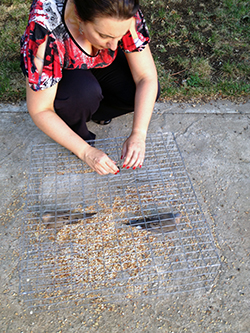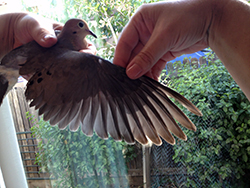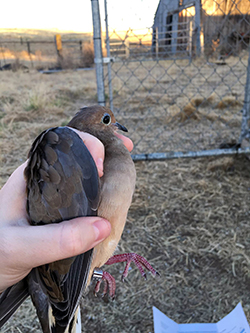
Two doves in a backyard wire trap

A bander holds out a dove’s wing to see which feather has most recently molted, which will provide information about the age of the bird.

A volunteer trapper prepares to release a banded female.
If you have an interest in migratory upland birds – as a hunter, a birdwatcher or just a citizen scientist – there’s a unique volunteer opportunity coming up that will allow you to work hands-on with wildlife, while helping the California Department of Fish and Wildlife collect critical research data that will become part of a national database.
Approved volunteers will be specifically trained over the next few months and permitted to capture mourning doves for a seven-week period, from July 1 through August 20, 2018. Banders attach a metal leg band to each bird, determine the bird’s age and sex , and record the data before releasing the bird. Banders can choose their own trapping sites, which in many cases are on their own property.
CDFW is particularly in need of volunteers in North Coast and Bishop areas, but as this is a statewide program, volunteers from other areas may be able to participate as well.
“It’s a unique opportunity for wildlife enthusiasts to get hands-on experience and play an important role in the management of California’s number one game bird,” explains Karen Fothergill, an environmental scientist and coordinator of CDFW’s Mourning Dove Banding Program.
Several levels of participation are possible, but successful completion of a four-hour training session is mandatory for all participants. Trained volunteers will band in their local areas, ending 10 days prior to the start of the hunting season for mourning doves.
The imprinted bands that are attached to birds’ legs are an important tool used by wildlife managers to help them evaluate mourning dove populations. Band recovery data is incorporated into the US Geological Survey Bird Banding Laboratory database and used by wildlife managers to monitor the status of mourning dove populations.
Together, the volunteer force will band approximately 4,000 mourning doves around the state. This number – which is necessary for accurate population modeling – has only been achieved with the use of volunteers.
Volunteer training opportunities will be held around the state, depending on how many potential volunteers show interest in participating, and where those individuals are located. Fothergill said that she expects to hold at least four training opportunities in the month of May. For scheduling purposes, potential volunteers are asked to contact Fothergill no later than April 13.
Volunteers are not compensated, but all supplies will be loaned at no charge.
Program participants must be over 18 and have good organizational skills and a commitment to wildlife preservation. The trapping and banding work is typically done in the morning and evening, but volunteers who can only work limited hours or on certain days can still be utilized and are welcome. For more detailed information about the program or to reserve a space at a training session, please contact Karen Fothergill at (916) 716-1461 or Karen.Fothergill@wildlife.ca.gov.
CDFW photos.
Top Photo: Mourning dove (Zenaida macroura)